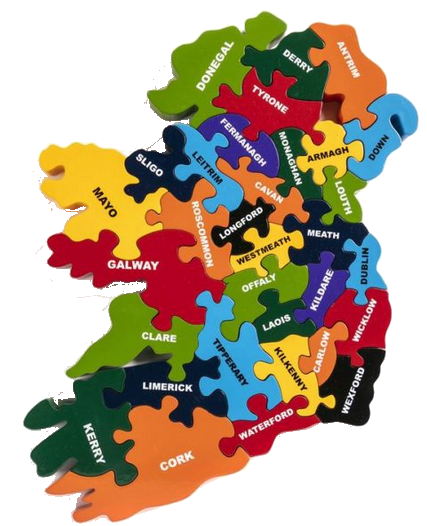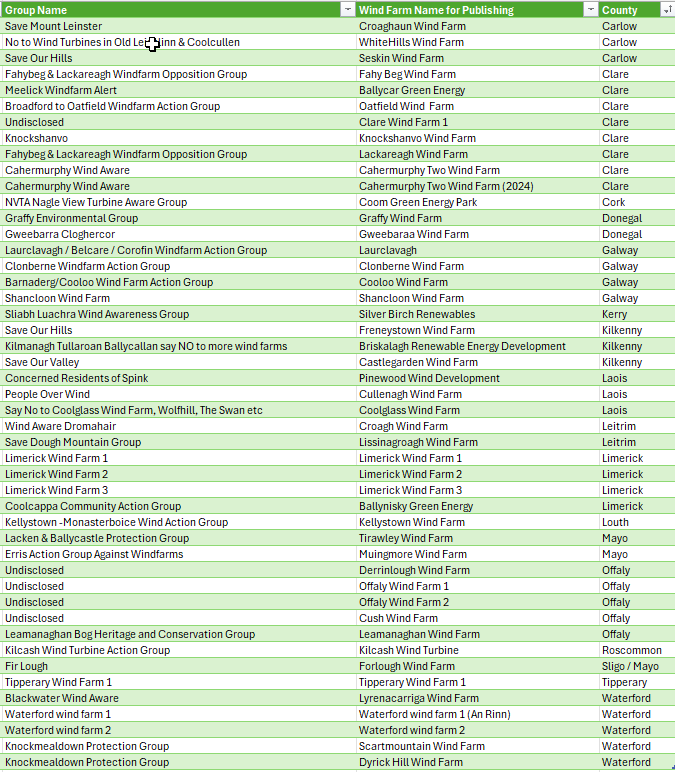Communities & Environmental Protection Alliance
Taking care of communities in our charge

AGAINST the GOLIATH
Old Leighlin tell their story which tells the CEPA Comunity story
Today's Issue by Micheál Martin
Current Taoiseach Micheál Martin raised concerns in 2013 about outdated guidelines and the lack of regulations for Large-Scale Wind Energy, which leds to inadequate protection for public health and the environment—a problem that still persists to this day.
Why/Our Mission
The Community Environmental Protection Alliance CEPA is an organisation founded by families and communities affected by industrial wind turbine developments in Ireland. Our mission is to safeguard natural resources, promote sustainable practices, raise awareness about environmental issues, advocate for environmental regulation policies, and nurture collaboration among community members.
At the heart of our mission is the protection of public health, well-being, and the environment.

Dáil Gathering for Robust Wind-farm Regulations
Gathering at the Dáil for Robust Wind-farm Regulation (21st May at 1pm )
01
Statutory Regulation for all operating wind farms
The implementation of statutory regulation and monitoring of wind farms is a crucial step towards ensuring the sustainable and responsible operation of these renewable energy sources. Such regulation consistent with WHO standards encompasses a set of legally binding rules and standards that wind farm operators must adhere to, aimed at minimizing environmental impacts, safeguarding wildlife, and ensuring the safety and efficiency of energy production. This regulatory framework often includes requirements for regular maintenance, noise control, shadow flicker mitigation, and the protection of bird and bat populations. By enforcing these regulations, governments can not only promote the generation of clean energy but also protect the interests of local communities and preserve natural ecosystems, ensuring that wind farms operate within an environmentally and socially responsible framework.
02
New Wind Energy Guideline that protects health and the environment
Ireland requirement for statutory regulations for the planning of wind farms has become increasingly evident as the country seeks to expand its renewable energy sources. These regulations must be best international practice are required to ensure that the development of wind energy projects is conducted in a manner that is both responsible and sustainable, addressing key concerns such as community health well-being, environmental impacts and the efficient use of land. By establishing clear criteria for site selection, design, and operation, Ireland aims to harness the potential of wind energy while minimizing negative effects on local ecosystems and populations, thus supporting the nation's commitment to sustainable development and green energy transition.
03
Stall all wind farm developments
A halt on all wind energy planning and development activities is necessary until new planning regulations/guidelines for wind energy are established to safeguard the communities they aim to serve..
Podcasts
Testimonials
People speak of their real life experience of living with Wind Turbines.
Clip • 6 Mins • 18 MAY • Saturday with Colm Ó Mongáin, Ossian Smyth, Minister of State at the Department of Public Expenditure and Reform; Ivana Bacik, Labour leader; Seán Canney, Independent TD for Galway East
Google MAP Tutorial
Video on how to create an interactive map of a wind farm in your area. Very useful when presenting to neighbors in your area the following:
1. Turbine Location.
2. Homes near Turbines.
3. Other point of interest near Turbines.
This map once created can be easily shared with any stakeholder.
Reeling in the years of Wind Energy Guideline
2006 - Wind Energy Guidelines - Still in place today

Wind Energy Development Guidelines 2006
All policies must be strategically environmentally assessed (SEA), no SEA exists for 2006 WEDGs, the current guidelines are not compliant with European law & SEA Directive. Published in 2004, the guidelines were labelled inadequate and yet they remain in place today.
2013 - New Draft Guidelines - Continuously delayed

A SEA process was followed in principle, the Department of Planning requested the position of the Department of Health on Wind Turbines.
Draft WEDGs were published 11th December 2013 by Minister Jan O’Sullivan
1. Noise limit of 40dBs flat Day & Night, outdoor limit with a further reduction of 10dB for indoor limit.
2. Mandatory setback of 500m.
3. No shadow flicker to occur.
Over 7,500 public submissions received, mostly relating to noise.
The Dept. of Health’s deputy CMO’s public health review was slammed by the wind lobby group. Dr Colette Bonner defended her position in the press “These people must be treated appropriately and sensitively as these symptoms can be very debilitating”.
It was debated (by Willie Penrose, TD) that the noise levels would not meet with the WHO nighttime requirements. By the end of 2014 the draft guidelines were shelved.
While multiple requests were made to the Minister, the revised guidelines were continuously delayed.
2017 - Revised Draft Guidelines - Preferred Draft Approach

Wind Energy Development Guidelines, “Preferred Draft Approach” 2017
13th June 2017, Ministers Simon Coveney & Denis Naughton issued a preferred draft approach with a commitment to undertake an SEA.
1. A noise limit consistent with World Health Organisation standards, relative rated noise limit of 5dB(A) above existing background noise within the range of 35 to 43dB(A) for both day and night, with 43dB(A) being the maximum noise limit permitted.
2. Noise monitoring of wind farms
The new noise limits are being proposed in tandem with the introduction of a new noise monitoring regime in relation to wind farms. Local authorities will enforce the noise limits as conditioned in the planning permission, in conjunction with the Environmental Protection Agency who will provide independent noise monitoring of wind farms. It is proposed that where there is evidence of non-compliance with noise limits, wind turbines will be required to be turned off until compliance with the noise limits is proven.
3. Mandatory setback of 500m, no less than 4 times the tip height between a wind turbine and the curtilage of a residential property,
4. The elimination of shadow flicker.
5. Consultation Obligations on Developers, requiring developers to have early and constructive consultation with communities on proposed wind farm developments before a planning application is made. In this regard, a Community Report will be required to be submitted with a planning application, outlining how the final proposal was shaped in response to those consultations.
On 26th June 2017 in the article “Windfarms 'louder than a bird' to be shut” Paul Melia interviewed Minister Denis Naughton who confirmed ‘The primary test now is sound, not setback… the one big issue which has come up is the sound issue. The standards (today) are unenforceable…” He also said that a condition of receiving payments from the State for producing clean energy would also require noise limits to be kept below the threshold.
In 2018, the WHO noise guidance for wind turbines recommended, that “For average noise exposure, the GDG conditionally recommends reducing noise levels produced by wind turbines below 45 dB Lden, as wind turbine noise above this level is associated with adverse health effects.
2019 - Revised Draft Guidelines - Abandoned

Wind Energy Development Guidelines 2019
An SEA document was developed however, there was no consultation with the Department of Health. The SEA actually references a target review with the public carried out in 2013.
Draft WEDGs were published in December 2019 by Minister Eoghan Murphy
1. Noise limit whereby the RRNL may not exceed 43 dB(A) which is the upper limit set by these consistent with the WHO Environmental Noise Guidelines for the European Region (WHO, 2018) metric for impacting human health.”
2. Elimination of shadow flicker
3. Minimum setback of 4 times the height of the turbine
In February 2020, the Department of Planning received a joint consultation signed by 13 global acousticians confirming over 320 inaccuracies in the government’s wind energy noise guidance. The report is critical of the Government’s SEA and confirms the guidance inaccurate conversion of the WHO limit, below 45 dB Lden should read 37 dB LA90, not 43 dB LA90.
2023 - Revised Draft Guidelines - Work in Progress

Wind Energy Development Guidelines 2023
An SEA is underway, but the Department of Planning is not consulting with the Department of Health. Consultation with competent health bodies is standard practice for wind energy SEAs in other jurisdictions. The government has made reference to targeted review, there has been no consultation with the public and we wonder if it is the targeted review of 2013, people's experience of living beside wind turbines 11 years ago.
In March 2023, the government tendered for a noise consultant to recommend an acceptable noise level. Any acoustician will say that noise levels cannot be discussed without considering the impact on population, we know people are not getting a night's sleep.
In June 20023 global acousticians arrived in Dublin for the Wind Turbine Noise Conference. The post conference report must be as concerning to you as it is to us.
“There was some talk in the streaming chat of wholly inappropriate local regulations being made under pressure from lobbyists. Of course, as scientists and engineers we resent politicians introducing regulations that we believe to be clearly inept!!”
The wind industry continues to exploit the 2006 planning guidelines
2024 - Revised Draft Guidelines - Work in Progress

Wind Energy Development Guidelines 2024
January 2024, the wind lobby issued wholly inappropriate promotional material, a ‘Wind Myths’ calendar. This was challenged and the Department of Health shows itself to be complicit, as it is not responding to public concerns.
The wind industry continues to exploit a lack of planning guidelines for profit. Planning applications include noise and shadow flicker assessments of substandard methodology and assumptions.
Contact us
Want to find out more

Wind Turbine Noise
Wind turbine noise is an environmental noise as is transport noise (road, rail, airports) and other industry noise. ‘It is well established that long-term exposure to noise above certain levels can lead to non-auditory health effects such as annoyance, sleep disturbance, negative effects on the cardiovascular and metabolic systems, and cognitive impairment in children.
CEPA.ie Community



